Abstract
Early childhood education is crucial in the development of a learned society. However, existing early childhood education focuses on languages, numbers, cultural and social interactions without much emphasis on the importance of the natural environment. Therefore, this study investigates the integration of biophilic design (BD) elements in kindergarten environments and their impact on early childhood environmental education (ECEE). Focusing on four kindergartens, the research examines how biophilic features influence children’s engagement with natural elements and their development. Utilizing a robust methodological framework, the study employs both observations and quantitative analysis using the Wilcoxon signed-rank test to assess the effectiveness of these interventions. The findings reveal that BD significantly enhances children’s interactions with natural terms, suggesting deeper cognitive connections with the natural world. Enhancements in children’s engagement with natural elements were most pronounced in kindergartens that implemented comprehensive and strategically placed biophilic elements. However, the effectiveness varied across settings, underscoring the importance of contextual and environmental factors in the design and implementation of biophilic principles. The study underscores the potential of BD to foster environmental awareness, cognitive and emotional development among children, advocating for its broader application in educational settings to promote sustainable environmental behaviors from an early age.
1. Introduction
The accelerating deterioration of global environmental conditions is driven by a web of interlinked social-ecological challenges, including climate change, pollution, ocean acidification, land degradation, and biodiversity loss [1]. Recognizing the urgency, scientists underscore the critical role of healthy, resilient ecosystems for all life forms, advocating for transformative changes in human behaviors related to production and consumption to mitigate these impacts [2]. This background underscores the vital importance of environmental education as a strategic approach to confront these extensive challenges.
Environmental education, conceptualized as a philosophy, a tool, and a profession, aims to foster an environmentally literate populace capable of engaging with sustainability and resource management issues effectively [3,4]. The development of environmental values, knowledge, and skills is seen as essential for nurturing proactive environmental behaviors across a person’s lifespan [5]. Given the dynamic nature of environmental challenges, continuous engagement and education are imperative to adapt and make informed decisions within community settings [6,7].
Particularly in early childhood, environmental education is crucial for seeding environmental literacy that influences later life behaviors and sensitivities [8]. Research indicates that early positive interactions with nature are foundational in cultivating a lifelong environmental concern and participation [8,9].
The fields of environmental education (EE) and early childhood education (ECE) have increasingly recognized the significant role that nature plays in the lives of young children. With growing interest in this area, both fields have evolved and converged, giving rise to a new interdisciplinary domain known as ECEE. ECEE emerges as a distinct approach within this framework, aimed at integrating direct nature-based experiences with developmental goals, which include physical, cognitive, and social-emotional benefits [10,11].
ECEE is dedicated to fostering young children’s understanding, appreciation, curiosity, and respect for the natural world, guided by age-appropriate educational frameworks [6,12,13,14]. The concept of biophilia, introduced by Wilson [15], suggests that humans possess an inherent tendency to connect with life and living systems. This principle has significantly influenced the development of ECEE. Numerous studies demonstrate that regular interaction with natural environments can enhance children’s academic performance, behavior, and stress levels [16,17,18,19], highlighting the crucial role that nature plays in child health and well-being.
By contrast, despite growing evidence on the benefits of nature-based experiences in early childhood, relatively few studies have systematically examined the direct impact of BD interventions—i.e., intentionally integrated natural features—cognitive engagement and well-being in authentic kindergarten settings. This gap underscores a need to explore how structured, purposeful introduction of biophilic elements can advance environmental education goals at the earliest stages of formal schooling.
Thus, this study seeks to apply BD elements in an intervention framework to explore their specific impacts on children within kindergarten settings. By integrating these natural elements, which are vital for fostering a deeper connection to the environment, the research aims to systematically assess how such interventions influence children’s behaviors and overall well-being. This approach advances the field of ECEE by introducing innovative biophilic strategies into educational practices. The findings from this study are expected to offer new insights into the effectiveness of biophilic interventions, contributing novel perspectives to the ongoing discourse on sustainable educational practices. This work underscores the critical importance of early environmental education and sets the stage for further research into how BD can be optimally utilized to enhance educational outcomes and promote environmental stewardship from a young age.
2. Literature Review
2.1. The Impact of ECEE on Child Development
The role of early childhood in influencing future environmental sensitivity, interests, and behaviors is increasingly recognized, positioning ECEE as a distinctive and essential form of environmental education. This field fosters a variety of methodologies and philosophical approaches aimed at integrating nature into early learning experiences [8,20]. Nature-based programs in early childhood not only aim to provide immersive natural experiences but also foster a fundamental appreciation for the natural world, supporting the developmental benefits associated with children’s exposure to nature [8,20,21]. These benefits span across physical aspects, such as increased activity levels and improved health conditions [22,23,24], cognitive domains including enhanced executive function and memory [25,26], and socio-emotional advantages like improved emotional regulation and social skills [27,28].
Lin, et al. [29] reported that increased connectivity with nature fosters higher levels of environmental knowledge, thereby altering human attitudes toward nature [30]. Indeed, human-nature connectedness (HNC) has been linked to a willingness to protect biodiversity [31,32]. Furthermore, studies indicate a positive correlation between BD and HNC with heightened environmental consciousness [33,34,35]. Nature-based preschools, forest kindergartens, and informal early childhood educational environments facilitate children’s exposure to and interaction with nature and the natural world in various ways [36]. The North American Association for Environmental Education (NAAEE) developed the “Guidelines for Excellence in ECEE Programs” in 2010, aiming to assist educators and other stakeholders in obtaining high-quality experiences in ECEE, asserting that the mission of ECEE is to establish connections between children and nature [37,38]. Additionally, there is evidence suggesting that the presence of nature contributes to the cognitive development of school-aged children [39].
In parallel to the United States’ North American Association for Environmental Education (NAAEE), China has also established its own comprehensive developmental guidelines for children aged 3–6. The strategies presented in Table 1 refer to these Chinese guidelines, which outline objectives and recommendations across various domains—health, language, social, science, and the arts. This emphasis on biophilic elements, particularly within health, science, and the arts, demonstrates China’s approach as a case study for how biophilic principles can be integrated into early childhood education at a national policy level. By illustrating both the NAAEE guidelines and the Chinese context, the present discussion underscores how diverse educational systems converge on the importance of nature-based learning. Table 1 delineates the specific goals and educational strategies for embedding these nature elements within the curriculum across these domains, underscoring their pivotal role in fostering comprehensive child development [40].

Table 1.
The objectives and educational suggestions for children in the field of science, art and health (based on China’s national guidelines).
In summary, ECEE significantly shapes young children’s environmental attitudes and behaviors. Integrating nature-based programs and ECEE into kindergarten not only promotes developmental gains across multiple domains but also instills a lasting appreciation for the natural world. By using China as a case study to illustrate its national guidelines and strategies, we highlight the global relevance of ECEE and how different educational systems—such as those in the United States and China—share a common priority of embedding nature within early learning. This alignment of educational practices underscores the universal importance of integrating nature-based environments into early childhood education.
2.2. Biophilic Design in Kindergarten Environments: Frameworks and Implications
BD goes beyond traditional design principles by establishing a profound and intricate connection with the built environment, which is rooted in our evolutionary dependence on nature for survival and personal fulfillment [41].
Unlike basic nature-inclusive designs, BD fosters a broader interaction with built environments, emphasizing not just the incorporation of natural elements but also the extraction of beneficial environmental patterns from human-nature interactions [42,43]. This approach leverages the HNC to enhance developmental outcomes, particularly in ECEE, where fostering a fundamental appreciation for nature supports biodiversity conservation and holistic child development [44,45]. This approach is not merely a return to nature in its primitive form but a strategic incorporation of natural elements and principles to address complex societal challenges, reexamining the interplay between natural and human-made forces [46,47,48].
A primary challenge in implementing BD in kindergartens involves developing a framework that supports children’s natural experiences effectively. This necessitates adherence to fundamental BD principles such as sustained engagement with nature and fostering emotional connections with the environment [39,47]. In integrating BD with ECEE, there is a shared objective to enhance educational spaces in ways that fundamentally support children’s developmental needs. This includes fostering their appreciation for and connection to the natural world, thereby ensuring that children grow up with a heightened awareness of and engagement with environmental issues. This dual focus not only enriches children’s learning environments but also aligns educational objectives with broader environmental conservation goals, making BD a strategic and necessary approach in contemporary educational planning. Existing biophilic models indicate that not all attributes are immediately suitable for young children, necessitating the development of a child-appropriate biophilic framework [49].
Research indicates that in some of the limited studies involving parent-child interactions in informal settings, it was found that direct experiences with nature facilitated the use of more natural terms during interactions, suggesting the profound impact of natural environments on learning, which is impactful, relevant, and immediately applicable [49,50].
This study adopts the most recent BD framework specifically Browning’s 14 patterns [51] and Kellert’s 24 attributes [39,52] to develop a biophilic approach tailored for kindergarten environments. Table 2 outlines the correlation and overlapping elements between these frameworks, highlighting elements such as water, plants, animals, natural landscapes, and ecosystems that are integral to direct natural experiences.

Table 2.
Comparison of direct and simulated biophilic elements in Browning’s and Kellert’s Frameworks.
This study tests existing biophilic implementation recommendations to evaluate actionable biophilic features that are feasible for current kindergarten settings. It establishes a biophilic framework within kindergarten architecture to conduct interventional observational experiments aimed at assessing the impact on children. Table 3 outlines the primary biophilic elements for implementing this framework.

Table 3.
Implementation of biophilic design elements in kindergartens.
3. Research Methodology
3.1. Criteria for the Selection of the Kindergarten
Curriculum planning in these kindergartens is grounded in naturalistic educational philosophies, providing children with increased opportunities to interact with biophilic elements prominently featured in both indoor and outdoor environments. Such consistent exposure to biophilic elements across these settings is essential, as it ensures continuous and coherent experiences with nature, thereby maximizing the developmental benefits associated with children’s regular contact with natural environments [53].
All selected kindergartens have been designated as provincial or municipal model institutions, affirming their effective implementation of the Chinese Ministry of Education’s guidelines on learning and development for kindergarten children, along with adherence to other relevant educational standards. These kindergartens adopt educational philosophies characterized by a holistic and integrative approach to child development for ages 3–6. Specifically, they emphasize children’s health and well-being through purposeful integration of BD principles, distinguishing them from typical programs that predominantly emphasize traditional academic instruction without intentional inclusion of nature-based elements. The detailed selection process for these kindergartens is illustrated in the flowchart (Figure 1).

Figure 1.
Screening process flowchart for four kindergartens in Henan, China.
Ultimately, for the facilitation of data collection and analysis, it was imperative that these kindergartens exhibit an active interest in participating in this research. All selected kindergartens conformed to these stipulations. The biophilic criteria applied to these kindergartens are delineated in Table 4.

Table 4.
Criteria of biophilic design in selected kindergartens.
3.2. Instrument
The instrument includes an in-class natural curriculum, taking the form of narrative responses, centered on the instructional syllabus of the curriculum itself. During each observation session, researchers used voice recording documentation and pictures of the indoor classrooms, to supplement the observation findings and assist in recording the environmental details of the project. Photographs of children during classroom and outdoor activities were also taken to help document the context.
The observation included a classroom-based Q&A exercise with prompts designed in collaboration with teachers to ensure comprehension by the children. Presented as open-ended questions, these prompts encouraged children to reflect on and narrate their experiences, focusing on aspects that elicited joy or intrigue:
- ▪
- “Can you tell me about something that made you particularly happy or interested recently in kindergarten?”
- ▪
- “If you were to share a story from kindergarten with a new friend, which one would you choose? Why?”
- ▪
- “Have you encountered anything unusual or special in kindergarten? Can you describe it?”
Children were prompted to describe their experiences across multiple sensory dimensions to reduce response bias and foster detailed descriptions. A pilot test with three children aged 5 to 6 confirmed the appropriateness of the questions and their ability to articulate experiences from at least three sensory perspectives, leading to no modifications of the three questions above.
3.3. Children’s Selection
According to Hughes, et al. [65] and Flavell, et al. [66], it is established that children aged four and older are capable of expressing their thoughts in a simple yet clear manner. This study employs a method that involves selecting participants who meet specific criteria aligned with the research objectives. The selection criteria for respondents are as follows: (1) The children must be enrolled in the designated kindergarten class; (2) they should have completed at least one semester within the kindergarten environment; and (3) they must be capable of articulating their thoughts clearly, as assessed by their teachers. This approach ensures that the sample comprises individuals who can provide meaningful insights relevant to the study.
To ensure the reliability of the data, new biophilic features were introduced at kindergartens A, B, C, and D. The four kindergartens had a total enrollment of 110 children. To obtain a representative sample while maintaining the feasibility of the study, one class from each of the four kindergartens was selected to participate in the experiment to measure biophilia. The selection of a single class per kindergarten was based on the need to control for variability in teacher-student interactions and to manage the observational workload effectively [67]. Kindergartens A, B, C, and D had participation from 28, 27, 26, and 29 children respectively. The data presented below includes comparisons made before and after the biophilic feature interaction among these 110 students.
3.4. Procedure
The biophilia measurement spanned ten weeks, with the specific scheduling illustrated in Figure 2. Children were tested shortly after returning to school at the beginning of September, following the summer vacation. Observations were paused for one week due to a public holiday from 29 September to 6 October. Utilizing the “Implementation of Biophilic Elements List” (Table 3), existing biophilic elements within the classroom spaces were cataloged, and additional potential elements were identified in collaboration with early childhood education (ECE) teachers and staff. Teachers participated in discussions and provided feedback regarding the selection, placement, and appropriateness of new biophilic elements introduced into the learning environments, ensuring alignment with educational objectives and daily classroom routines. The Biophilic Elements List was used not for scoring the spaces but rather for assessing the attributes of these elements with indicative checks (✔) or crosses (X). Photographic documentation of each classroom’s current biophilic attributes was conducted to determine the number and types of biophilic elements to be implemented during the intervention.

Figure 2.
Intervention observation trial schedule.
Upon finalizing this instrument, the materials were submitted to the UMREC Institutional Review Board (IRB) for review and approval. The approval was duly granted and stamped by the UMREC IRB office, and consent forms were distributed to parents by the teachers prior to the commencement of the study. All signed consent forms were collected before the initiation of the assessment. The intervention or selection of alternate classes would not proceed without parental consent. Each child was assigned a unique identifier by the teachers to facilitate the comparison of pre- and post-test data. Any child absent from either the pre-test or post-test was excluded from the study, as comparative data could not be generated.
3.5. Data Collection and Coding
The intervention observation phase was meticulously planned to capture authentic responses from children to biophilic elements integrated into their kindergarten environments. Data collection included pre- and post-interaction assessments across four kindergartens, employing uniform questions designed to elicit expressive communication within a 30–35-min timeframe. The main teaching instructor led the interactive observation sessions. To ensure data integrity and precision, the study employed graduate students with relevant expertise as coders, with the researcher taking detailed notes. A comprehensive biophilic implementation checklist (Table 3) was provided to observers to guide documentation of key elements.
Preparatory measures to safeguard data integrity included:
- ▪
- Observer Training: Ensured uniform identification and recording of children’s interactions with their environment.
- ▪
- Validation Procedures: Used multiple independent observers to assess the same settings, ensuring consistent observational results.
- ▪
- Ethical Considerations: Implemented strategies to protect children’s privacy and welfare, opting against video recording based on parental feedback.
- ▪
- Technical Support: Employed audio recordings and selective photography, with school permission, to enhance data analysis.
After ten weeks, the teachers conducted post-interaction assessments within the same 30–35-min timeframe as the pre-tests. Consistency in coding was maintained, with a team of three observers reviewing narrative content for alignment with in-situ records. A rubric (see Supplementary Materials’ Table S1) was provided, detailing encoding guidelines for children’s narratives, including exemplars for ambiguous content. This rubric also helped observers discern the context for accurate frequency determination of biophilic categories.
Observers collated frequencies of references to water, plants, animals, natural landscapes, and ecosystems in children’s narratives. Discrepancies were reconciled through consensus before finalizing counts and codes. This rigorous process ensured the production of reliable, detailed data for subsequent analysis of the biophilic interventions’ effectiveness.
3.6. Biophilic Kindergarten Case Studies
This paper presents direct feedback from the research subjects—children—articulated from a first-person viewpoint. To elucidate the intent behind observations, each kindergarten floor plan is annotated to highlight biophilic features, as depicted in Figure 3. Biophilic elements within the kindergarten settings are color-coded for clear differentiation: blue represents water features, green signifies plant life, purple denotes animal elements, and orange is used for natural landscapes or ecosystems. Additionally, red dots indicate new facilities, and yellow dots mark existing features.

Figure 3.
Biophilic intervention icons.
These biophilic features are categorized according to Table 3, “Implementation of BD elements in kindergartens”, as reviewed in the literature. Figure 4, Figure 5, Figure 6, Figure 7, Figure 8, Figure 9, Figure 10 and Figure 11 illustrate how each kindergarten has integrated these features into both indoor and outdoor environments, aligning with the site context. Table 5 introduces each case study between the figures, highlighting the specific biophilic features applied across the various kindergarten settings. This approach ensures a systematic presentation of the biophilic elements, facilitating an intuitive understanding of the environmental enhancements and their spatial distribution within the kindergartens.
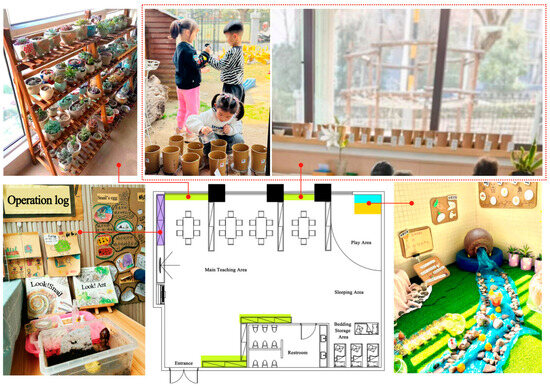
Figure 4.
Indoor schematic of biophilic features in Kindergarten A.
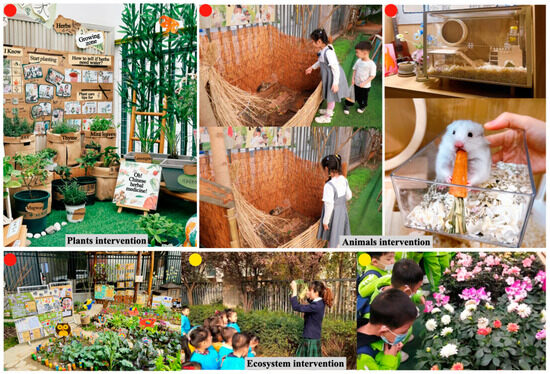
Figure 5.
Outdoor schematic of biophilic features in Kindergarten A.
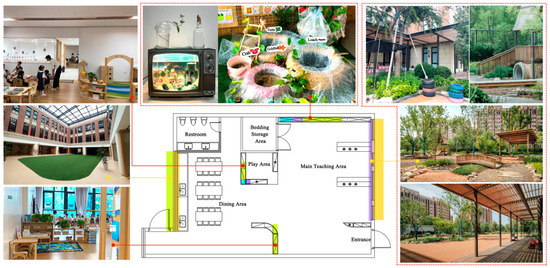
Figure 6.
Indoor schematic of biophilic features in Kindergarten B.
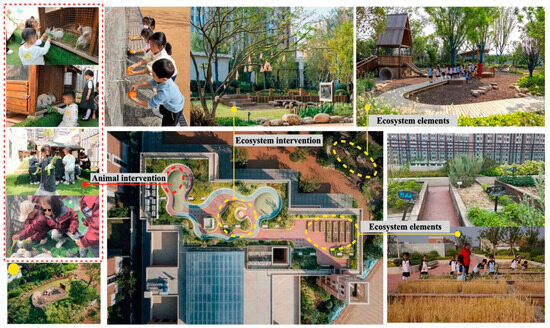
Figure 7.
Outdoor schematic of biophilic features in Kindergarten B.
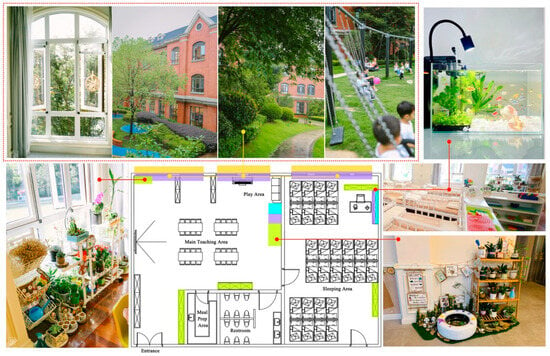
Figure 8.
Indoor schematic of biophilic features in Kindergarten C.
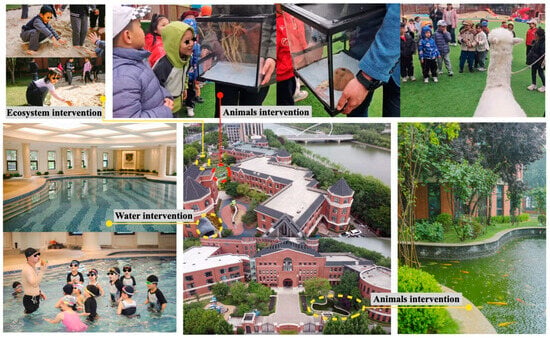
Figure 9.
Outdoor schematic of biophilic features in Kindergarten C.
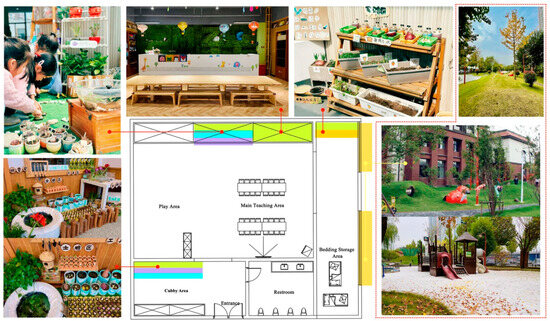
Figure 10.
Indoor schematic of biophilic features in Kindergarten D.
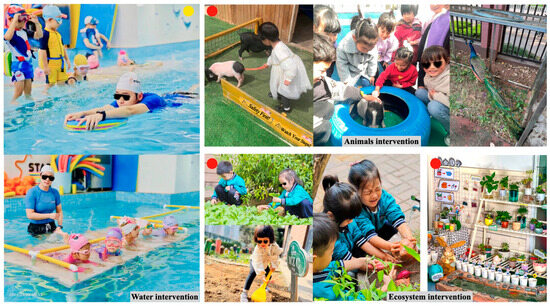
Figure 11.
Outdoor schematic of biophilic features in Kindergarten D.

Table 5.
Overview of Biophilic Design Features Across Kindergarten Settings.
3.7. Statistical Analysis
In the analytical process, SPSS V26.0 software was utilized to conduct initial normality tests to determine the appropriate statistical methods for comparing pre- and post- interaction data. Normality was assessed using skewness, kurtosis, and Shapiro-Wilk test results, which collectively indicated non-normality in the data distribution, as detailed in Supplementary Materials’ Table S3.
Given these findings, the Wilcoxon signed-rank test was identified as the most suitable analytical tool for this dataset. As a nonparametric test, the Wilcoxon test is especially beneficial because it is robust against non-normal data distributions [68], thereby providing a reliable and valid method for inferential analysis. Consequently, this test was chosen for analyzing the differences between pre- and post-interaction outcomes. Specifically, the analysis focused on comparing the frequency and nature of children’s interactions with biophilic elements before the intervention and after the intervention. The pre-interaction data, collected from four different kindergartens, showed varying levels of skewness and kurtosis, indicating non-normal distributions. For example, the skewness ratios for categories like A-Plants (5.182), B-Animals (10.213), and C-Water (10.358) were significantly high, along with kurtosis ratios such as A-Ecosystem (16.729), B-Total (27.910), and D-Total (26.731). Post-interaction data revealed significant changes, with Shapiro-Wilk test results indicating non-normality across all categories (p < 0.05). These detailed comparisons underscore the efficacy of the intervention and the robustness of the Wilcoxon test in handling non-normally distributed data.
3.8. Observational Insights
This study also cataloged the educational activities at the four kindergartens during the observation period and described unexpected incidents during the intervention to ensure a fair and rigorous assessment of the outcomes. (see Supplementary Materials’ Table S2).This comprehensive analytical strategy enhanced the fairness and accuracy of the findings, providing a balanced perspective on how biophilic interventions interact with and complement the overall educational environment. Ultimately, the breadth of this approach aims to increase the credibility and depth of the research outcomes, offering compelling evidence for integrating BD elements into initiatives that promote children’s health and well-being
4. Results
4.1. Children’s Responses to Biophilic Interaction
According to Table 6, the impact of BD features were analyzed across four kindergartens. Kindergarten A showed the least change among the four, with median interactions only slightly increasing from 1 to 2 and the 75th percentile from 2.75 to 3.75, while mean interactions rose from 2.5 to 4.9. In stark contrast, Kindergarten D exhibited the most significant increase, with median interactions jumping from 1 to 5, and mean interactions from 2.56 to 9.92, indicating a robust response to the biophilic interventions.

Table 6.
Comparative descriptive statistics of children’s terms with biophilic elements before and after interventions.
Regarding specific biophilic elements, the water element in Kindergarten A unexpectedly showed a decrease in post-features, with mean scores dropping from 0.6 to 0.4. Conversely, Kindergarten D saw a significant improvement, with the 75th percentile rising from 0 to 2 and mean scores increasing from 0.24 to 2.16, marking a substantial enhancement in water-related interactions. Similarly, the plant element demonstrated notable increases in Kindergartens B and D, where mean scores rose from 1.08 to 2.23 and from 0.8 to 2.88, respectively.
For the animal element, Kindergarten A displayed a downward trend, with a decrease in mean interactions from 0.7 to 0.6, despite an increase in the 75th percentile from 0.75 to 1. However, the ecosystem element saw significant increases across all kindergartens, with Kindergarten B and D observing rises in the 75th percentile to 3 and notably higher mean scores.
4.2. Children’s Post-Biophilic Features Interaction Impact on Children’s Vocabulary
The statistical analysis presented in Table 7 uses the Wilcoxon signed-rank test and the Sign Test to evaluate the changes in children’s nature terms with biophilic elements pre- and post-features interactions across four kindergartens. The Wilcoxon Test, a non-parametric measure, was applied to ascertain differences where data distributions were not assumed to be normal.

Table 7.
Summary of statistical analyses on the impact of biophilic design elements at studied kindergartens.
The overall trend indicated an increase in the frequency of terms related to biophilic elements post-features, with significant p-values (Sig. < 0.05) observed in most comparisons. This suggests a substantial increase in children’s references vocabulary to these nature elements following the implementation of BD interventions
In the water element (AW, BW, CW, DW), notably, results for Kindergarten A (AW) did not show a significant increase post-interaction (Z = −1.027, p = 0.305). In contrast, Kindergarten D (DW) experienced significant enhancements, with a Z-score of −3.703 (p = 0.000), indicating robust improvements in nature terms with water elements.
The plant element also showed significant improvements (AP, BP, CP, DP) The interactions with plant elements showed significant improvements in Kindergartens B (BP) and D (DP). Kindergarten B’s plant interactions improved with a Z-score of −2.571 (p = 0.010), while Kindergarten D showed a substantial rise (Z = −2.755, p = 0.006).
Animal interactions varied across the kindergartens (AA, BA, CA, DA). For instance, Kindergarten A (AA) showed no significant change (Z = −0.491, p = 0.623), whereas significant increases were found in Kindergarten C (CA) with a Z-score of −3.836 (p = 0.000).
Ecosystem interactions uniformly showed positive improvements across all kindergartens (AE, BE, CE, DE), with particularly strong results in Kindergartens B and C. For example, Kindergarten B (BE) and C (CE) demonstrated substantial increases, with Z-scores of −3.286 (p = 0.001) and −4.304 (p = 0.000) respectively.
Similarly, the Sign test results support the findings from the Wilcoxon test, with several positive differences indicating increases in interactions with nature. The statistical significance values further corroborate these observations, especially notable in the Total and Ecosystem categories across all kindergartens.
5. Discussion
5.1. Main Findings
This study assessed the efficiency of BD elements in enhancing children’s engagement with natural terms within kindergarten environments. Results for both the Wilcoxon Signed-Rank Test and the Sign Test consistently suggest significant increases in the use of natural terms post-interaction, particularly in Kindergartens B and D, suggesting that BD can effectively foster a deeper interaction between children and the natural environment. These results align with previous research emphasizing the importance of nature-based experiences in early childhood education [8,10] and support the biophilia hypothesis [15,53,69], which posits an innate human affinity towards nature. This study extends the hypothesis by quantitatively demonstrating how direct interactions with biophilic elements can enhance children’s descriptions of their surroundings, reflecting greater cognitive engagement.
The variation in results across different kindergartens highlights the potential influence of each setting’s unique environmental context and the ways in which biophilic elements are introduced. For example, Kindergarten A did not show significant improvements in water and animal elements, partly due to overwatering snails and succulents before a long holiday break, causing excessive humidity, snail mortality, and the rotting of succulents. Although teachers initially advised on element placement, their absence during the break and insufficient care protocols led to negative outcomes. This underscores the essential role of consistent teacher involvement in both introducing and maintaining biophilic features. Teachers, who understand children’s routines and contexts, are best positioned to guide active engagement, foster responsibility for natural elements, and integrate biophilic components into daily activities.
Conversely, Kindergarten B exhibited the most considerable improvements in water and ecosystem landscape elements. The extensive ecological landscapes on the rooftops and the kindergarten’s yard, as evident from Intervention Figure 6, made the biophilic impact more pronounced compared to other institutions. Moreover, Kindergartens C and D demonstrated substantial overall improvements, highlighting how well-designed and strategically placed biophilic elements can significantly enhance children’s contact with nature. Despite the occurrence of animal deaths in Kindergarten C as well, prompt remedial actions by the teachers mitigated any negative impact on the children. Notably, the presence of swimming facilities in Kindergartens C and D likely contributed to the significant enhancements observed in water-related interactions, suggesting that including swimming pools in BD may beneficially increase children’s frequency of contact with water elements.
Overall, these findings underscore the value of integrating BD into educational environments to promote environmental awareness and support cognitive and emotional development. Crucially, they highlight how robust teacher engagement—from planning and implementation to day-to-day maintenance—can bolster the positive impact of biophilic interventions. When thoughtfully introduced and consistently supported, these interventions yield beneficial outcomes, enrich children’s natural engagements, and advance broader educational objectives.
5.2. Theoretical Implications
By employing a structured, quantitative approach to measure children’s use of nature-related terms, this study bridges a gap in existing ECEE literature, which often relies on more qualitative or observational methods. This research provides concrete quantitative evidence, offering measurable indicators of cognitive and linguistic engagement fostered by BD. The findings underscore the efficacy of direct interaction with biophilic elements in promoting environmental engagement, thereby extending the biophilia hypothesis explicitly into an early childhood education context. Moreover, the study reveals that differences in local implementation can shape children’s outcomes, suggesting that the underlying theoretical framework must account for variations in environmental setting, instructional support, and cultural norms.
5.3. Managerial and Practical Implications
From an implementation perspective, these results highlight the crucial need for educational administrators and kindergarten staff to plan, maintain, and scaffold children’s interactions with natural elements. Facilities that incorporate accessible water features, living organisms, and ecosystem landscapes—alongside regular teacher-led engagement—are more likely to see enhanced children’s use of nature-related vocabulary and richer environmental experiences. Additionally, teacher professional development programs focusing on routine care of biophilic features and curriculum integration can further optimize these interventions. Collectively, these managerial strategies can help schools and policymakers align resource allocation, teacher training, and curricular design to foster deeper, more consistent connections with nature in early childhood education.
6. Conclusions
This research substantiates the beneficial impact of BD within kindergarten environments on fostering children’s naturalistic interactions and environmental engagement. The integration of biophilic elements not only enhances children’s use of natural terms—reflecting a deeper cognitive and emotional interaction with nature—but also supports broader developmental and educational goals. These findings align with the biophilia hypothesis, which posits an innate human affinity for nature, suggesting that well-implemented BD can significantly enrich children’s interactions with and awareness of the environment.
Moreover, the study highlights the importance of tailored biophilic interventions. Notably, Kindergartens C and D showed significantly greater improvements in water-related interactions compared to others, suggesting that incorporating spaces for swimming pools in the BD model could further enhance these elements. The successes observed in Kindergartens B and D particularly demonstrate how strategic placement and thoughtful integration of natural elements can profoundly enhance the educational environment and support the holistic development of children.
Ultimately, this comprehensive analysis advocates for the systematic incorporation of biophilic elements into ECEE as a means to promote sustainability and environmental stewardship from a young age. By providing a methodological blueprint for evaluating such interventions, this study contributes to the growing body of evidence supporting the integration of nature-based, biophilic practices in education, aiming to cultivate an early appreciation for and engagement with the natural world. This approach not only benefits children’s development but also aligns with global sustainability goals, advocating for educational practices that foster environmentally aware and empathetic future citizens.
Limitations and Future Research
Several limitations warrant consideration. Primarily, the study’s reliance on short-term data collection restricts the understanding of the long-term effects of BD on children’s development and environmental attitudes. Future research should focus on longitudinal studies to examine these sustained impacts and elucidate the developmental trajectories over extended periods.
Moreover, the confined scope of the interventions, limited to specific types of biophilic elements, suggests the need to diversify the biophilic components in future studies. Including a broader array of sensory experiences, such as auditory and tactile elements, could provide a more comprehensive understanding of the multidimensional impacts of BD on child development. Expanding the range of natural elements and interaction opportunities will allow for a richer assessment of how different aspects of nature influence children’s learning and development.
Additionally, the effectiveness of the biophilic features varied across different kindergartens, indicating that external factors like the initial environmental setup and specific intervention designs might significantly influence outcomes. Comparative studies across various educational settings and cultural contexts could further identify best practices and refine BD strategies to maximize their effectiveness.
Furthermore, future research should more thoroughly incorporate teacher training, collaboration, and ongoing professional development as a core aspect of biophilic interventions. Educators—who understand the children’s daily routines, developmental needs, and community contexts—play a pivotal role in maintaining biophilic features, guiding children’s inquiry, and embedding environmental values into everyday learning. By engaging teachers as partners, subsequent studies can examine how professional support, curricular alignment, and explicit teacher involvement enhance children’s sustained interaction with biophilic elements and deepen their environmental awareness.
By addressing these limitations and broadening the research scope to include more diverse environmental settings within kindergartens, future research can more effectively delineate the parameters under which BD can be most beneficial. Pursuing these research directions will help elucidate the role of BD in enhancing early childhood education, fostering a lifelong connection with the natural world, and promoting sustainable behavioral patterns. This comprehensive approach will ultimately guide the development of interventions that nurture children’s innate affinity for nature and support environmental stewardship from a young age.
Supplementary Materials
The following supporting information can be downloaded at: https://www.mdpi.com/article/10.3390/su17073077/s1, Table S1: Narrative Coding Rubric for Children’s Storytelling Responses; Table S2: Outdoor and Nature-Themed Activity Schedule and Intervention Incidents Across Four Kindergartens; Table S3: Normality Test Results for Quantitative Data.
Author Contributions
Conceptualization, H.D. and M.A.I.; methodology, H.D. and R.S.; software, H.D. and R.S.; validation, H.D., M.A.I. and R.S.; formal analysis, H.D. and M.A.I.; investigation, H.D.; resources, H.D.; data curation, H.D.; writing—original draft preparation, H.D.; writing—review and editing, M.A.I.; visualization, H.D.; supervision, M.A.I. and R.S. All authors have read and agreed to the published version of the manuscript.
Funding
This research received no external funding.
Institutional Review Board Statement
This study obtained the Universiti Malaya Research Ethics Committee approval (ref no. UM.TNC2/UMREC_2858; 7 September 2023).
Informed Consent Statement
Informed consent was obtained from all subjects involved in the study.
Data Availability Statement
Data included in article/Supplementary Materials.
Acknowledgments
The authors would like to express their sincere gratitude to all the research participants who made this study possible. To enhance the clarity and readability of the manuscript, the authors used Quillbot for language proofreading during the writing process. All content generated through this tool was carefully reviewed and edited by the authors, who take full responsibility for the final version of the publication.
Conflicts of Interest
The authors declare that they have no known competing financial interests or personal relationships that could have appeared to influence the work reported in this paper.
References
- Reyers, B.; Selig, E.R. Global targets that reveal the social–ecological interdependencies of sustainable development. Nat. Ecol. Evol. 2020, 4, 1011–1019. [Google Scholar] [PubMed]
- Díaz, S.; Settele, J.; Brondízio, E.S.; Ngo, H.T.; Agard, J.; Arneth, A.; Balvanera, P.; Brauman, K.A.; Butchart, S.H.; Chan, K.M.; et al. Pervasive human-driven decline of life on Earth points to the need for transformative change. Science 2019, 366, eaax3100. [Google Scholar] [CrossRef]
- Gamage, S. Environmental education for sustainability: Environment literacy and action-oriented teaching. In Environment and Sustainable Development; Routledge: Delhi, India, 2021; pp. 31–49. [Google Scholar]
- Shutaleva, A.; Nikonova, Z.; Savchenko, I.; Martyushev, N. Environmental education for sustainable development in Russia. Sustainability 2020, 12, 7742. [Google Scholar] [CrossRef]
- Mastrángelo, M.E.; Pérez-Harguindeguy, N.; Enrico, L.; Bennett, E.; Lavorel, S.; Cumming, G.S.; Abeygunawardane, D.; Amarilla, L.D.; Burkhard, B.; Egoh, B.N.; et al. Key knowledge gaps to achieve global sustainability goals. Nat. Sustain. 2019, 2, 1115–1121. [Google Scholar]
- Marouli, C. Sustainability education for the future? Challenges and implications for education and pedagogy in the 21st century. Sustainability 2021, 13, 2901. [Google Scholar] [CrossRef]
- Leal Filho, W.; Mifsud, M.; Pace, P. Handbook of Lifelong Learning for Sustainable Development; Springer: Berlin/Heidelberg, Germany, 2018. [Google Scholar]
- Ardoin, N.M.; Bowers, A.W. Early childhood environmental education: A systematic review of the research literature. Educ. Res. Rev. 2020, 31, 100353. [Google Scholar]
- Asah, S.T.; Bengston, D.N.; Westphal, L.M.; Gowan, C.H. Mechanisms of children’s exposure to nature: Predicting adulthood environmental citizenship and commitment to nature-based activities. Environ. Behav. 2018, 50, 807–836. [Google Scholar]
- Chawla, L. Benefits of nature contact for children. J. Plan. Lit. 2015, 30, 433–452. [Google Scholar] [CrossRef]
- Dopko, R.L.; Capaldi, C.A.; Zelenski, J.M. The psychological and social benefits of a nature experience for children: A preliminary investigation. J. Environ. Psychol. 2019, 63, 134–138. [Google Scholar]
- Bailie, P.E. Connecting Children to Nature: A Multiple Case Study of Nature Center Preschools; The University of Nebraska-Lincoln: Lincoln, NE, USA, 2012. [Google Scholar]
- Bendini, M.; Devercelli, A. Quality Early Learning: Nurturing children’s Potential; World Bank Publications: Washington, DC, USA, 2022. [Google Scholar]
- Green, K.T. Environmental Awareness in Early Years Education: A Systematic Content Analysis on Research from Different Countries; University of Saskatchewan: Saskatoon, Canada, 2022. [Google Scholar]
- Wilson, E.O. Biophilia; Harvard University Press: Cambridge, MA, USA, 1984. [Google Scholar]
- Vella-Brodrick, D.A.; Gilowska, K. Effects of nature (greenspace) on cognitive functioning in school children and adolescents: A systematic review. Educ. Psychol. Rev. 2022, 34, 1217–1254. [Google Scholar]
- Wells, N.M.; Evans, G.W. Nearby nature: A buffer of life stress among rural children. Environ. Behav. 2003, 35, 311–330. [Google Scholar]
- Bowler, D.E.; Buyung-Ali, L.M.; Knight, T.M.; Pullin, A.S. A systematic review of evidence for the added benefits to health of exposure to natural environments. BMC Public Health 2010, 10, 456. [Google Scholar]
- Weeland, J.; Moens, M.A.; Beute, F.; Assink, M.; Staaks, J.P.; Overbeek, G. A dose of nature: Two three-level meta-analyses of the beneficial effects of exposure to nature on children’s self-regulation. J. Environ. Psychol. 2019, 65, 101326. [Google Scholar]
- Johnstone, A.; Martin, A.; Cordovil, R.; Fjørtoft, I.; Iivonen, S.; Jidovtseff, B.; Lopes, F.; Reilly, J.J.; Thomson, H.; Wells, V.; et al. Nature-based early childhood education and children’s social, emotional and cognitive development: A mixed-methods systematic review. Int. J. Environ. Res. Public Health 2022, 19, 5967. [Google Scholar] [CrossRef] [PubMed]
- Ashley, R. Constructing Perspectives of Child-Nature Relationships in Early Learning Curriculum Frameworks; Mount Saint Vincent University: Halifax, Canada, 2022. [Google Scholar]
- Kondo, M.C.; Fluehr, J.M.; McKeon, T.; Branas, C.C. Urban Green Space and Its Impact on Human Health. Int. J. Environ. Res. Public Health 2018, 15, 445. [Google Scholar] [CrossRef]
- Coventry, P.A.; Brown, J.E.; Pervin, J.; Brabyn, S.; Pateman, R.; Breedvelt, J.; Gilbody, S.; Stancliffe, R.; McEachan, R.; White, P.L. Nature-based outdoor activities for mental and physical health: Systematic review and meta-analysis. SSM-Popul. Health 2021, 16, 100934. [Google Scholar]
- White, M.P.; Elliott, L.R.; Gascon, M.; Roberts, B.; Fleming, L.E. Blue space, health and well-being: A narrative overview and synthesis of potential benefits. Environ. Res. 2020, 191, 110169. [Google Scholar]
- Mason, L.; Ronconi, A.; Scrimin, S.; Pazzaglia, F. Short-term exposure to nature and benefits for students’ cognitive performance: A review. Educ. Psychol. Rev. 2022, 34, 609–647. [Google Scholar]
- Ernst, J.; Sobel, D.; Neil, A. Executive function in early childhood: Harnessing the potential of nature-based practices to elevate and equalize outcomes. Front. Educ. 2022, 7, 1011912. [Google Scholar]
- McCree, M.; Cutting, R.; Sherwin, D. The Hare and the Tortoise go to Forest School: Taking the scenic route to academic attainment via emotional wellbeing outdoors. In Young Children’s Emotional Experiences; Routledge: Oxfordshire, UK, 2020; pp. 106–122. [Google Scholar]
- Bang, K.-S.; Kim, S.; Song, M.K.; Kang, K.I.; Jeong, Y. The Effects of a Health Promotion Program Using Urban Forests and Nursing Student Mentors on the Perceived and Psychological Health of Elementary School Children in Vulnerable Populations. Int. J. Environ. Res. Public Health 2018, 15, 1977. [Google Scholar] [CrossRef]
- Lin, B.B.; Egerer, M.H.; Ossola, A. Urban Gardens as a Space to Engender Biophilia: Evidence and Ways Forward. Front. Built Environ. Rev. 2018, 4, 79. [Google Scholar] [CrossRef]
- Wijesooriya, N.; Brambilla, A. Bridging biophilic design and environmentally sustainable design: A critical review. J. Clean. Prod. 2021, 283, 124591. [Google Scholar]
- Soga, M.; Gaston, K.J.; Yamaura, Y.; Kurisu, K.; Hanaki, K. Both Direct and Vicarious Experiences of Nature Affect Children’s Willingness to Conserve Biodiversity. Int. J. Environ. Res. Public Health 2016, 13, 529. [Google Scholar] [CrossRef] [PubMed]
- Zhang, W.; Goodale, E.; Chen, J. How contact with nature affects children’s biophilia, biophobia and conservation attitude in China. Biol. Conserv. 2014, 177, 109–116. [Google Scholar]
- Rosa, C.D.; Collado, S. Experiences in Nature and Environmental Attitudes and Behaviors: Setting the Ground for Future Research. Front. Psychol. Rev. 2019, 10, 763. [Google Scholar] [CrossRef]
- Boiral, O.; Heras-Saizarbitoria, I.; Brotherton, M.-C. Nature connectedness and environmental management in natural resources companies: An exploratory study. J. Clean. Prod. 2019, 206, 227–237. [Google Scholar] [CrossRef]
- Marczak, M.; Sorokowski, P. Emotional Connectedness to Nature Is Meaningfully Related to Modernization. Evidence From the Meru of Kenya. Front. Psychol. Brief Res. Rep. 2018, 9, 1789. [Google Scholar] [CrossRef]
- Lee, J.C.-K.; Ma, W.H.T. Early childhood environmental education: A Hong Kong example. Appl. Environ. Educ. Commun. 2006, 5, 83–94. [Google Scholar]
- North American Association for Environmental Education (NAAEE). Early Childhood Environmental Education Programs: Guidelines for Excellence; NAAEE: Washington, DC, USA, 2010; Available online: https://eepro.naaee.org/sites/default/files/eepro-post-files/early_childhood_ee_guidelines.pdf (accessed on 29 March 2024).
- Born, P. Regarding Animals: A Perspective on the Importance of Animals in Early Childhood Environmental Education. Int. J. Early Child. Environ. Educ. 2018, 5, 46–57. [Google Scholar]
- Browning, W.D.; Ryan, C.O. Nature Inside: A Biophilic Design Guide; Routledge: Oxfordshire, UK, 2020. [Google Scholar]
- Ministry of Education of the People’s Republic of China. The Guidelines for the Learning and Development of Children Aged 3–6; Ministry of Education of the PRC: Beijing, China, 2020.
- Kellert, S.R.; Edward, W.O. The Biophilia Hypothesis; Island Press: Washington, DC, USA, 1993. [Google Scholar]
- Ramzy, N.S. Biophilic qualities of historical architecture: In quest of the timeless terminologies of ‘life’ in architectural expression. Sustain. Cities Soc. 2015, 15, 42–56. [Google Scholar] [CrossRef]
- Gatersleben, B.; Andrews, M. When walking in nature is not restorative—The role of prospect and refuge. Health Place 2013, 20, 91–101. [Google Scholar] [CrossRef]
- Gillis, K.; Gatersleben, B. A review of psychological literature on the health and wellbeing benefits of biophilic design. Buildings 2015, 5, 948–963. [Google Scholar] [CrossRef]
- Larsen, L.; Adams, J.; Deal, B.; Kweon, B.S.; Tyler, E. Plants in the workplace: The effects of plant density on productivity, attitudes, and perceptions. Environ. Behav. 1998, 30, 261–281. [Google Scholar] [CrossRef]
- Kellert, S. Biophilic urbanism: The potential to transform. Smart Sustain. Built Environ. 2016, 5, 4–8. [Google Scholar]
- Kellert, S.; Calabrese, E. The Practice of Biophilic Design; Terrapin Bright LLC: London, UK, 2015. [Google Scholar]
- Nitu, M.A.; Gocer, O.; Wijesooriya, N.; Vijapur, D.; Candido, C. A biophilic design approach for improved energy performance in retrofitting residential projects. Sustainability 2022, 14, 3776. [Google Scholar] [CrossRef]
- Thea, C.-F.; Ross, M.; Ludovica, S.; Joanna, M.; Merideth, G. Plant Yourself Where Language Blooms: Direct Experience of Nature Changes How Parents and Children Talk about Nature. Child. Youth Environ. 2017, 27, 110–124. [Google Scholar] [CrossRef]
- Gregersen, T.; Mercer, S. The Routledge Handbook of the Psychology of Language Learning and Teaching; Routledge, Taylor & Francis Group: Oxfordshire, UK, 2022. [Google Scholar]
- Browning, W.D.; Ryan, C.O.; Clancy, J.O. 14 Patterns of Bophilic Design; Terrapin Bright Green, LLC: New York, NY, USA, 2014. [Google Scholar]
- Browning, W.; Ryan, C. What is Biophilia and What Does It Mean for Buildings and Spaces? Nature Inside: A Biophilic Design Guide; RIBA Publishing: London, UK, 2020; p. 192. [Google Scholar] [CrossRef]
- Kellert, S.R. Nature by Design: The Practice of Biophilic Design; Yale University Press: New Haven, CT, USA, 2018. [Google Scholar]
- Nieuwenhuis, M.; Knight, C.; Postmes, T.; Haslam, S.A. The relative benefits of green versus lean office space: Three field experiments. J. Exp. Psychol. Appl. 2014, 20, 199. [Google Scholar] [PubMed]
- Qin, J.; Sun, C.; Zhou, X.; Leng, H.; Lian, Z. The effect of indoor plants on human comfort. Indoor Built Environ. 2014, 23, 709–723. [Google Scholar] [CrossRef]
- Ibrahim, I.A.; Al-Chaderchi, B.M. Contribution of the Biophilic Design Approach to the UN Sustainable Development Goals. Eco-Archit. IX Harmon. Between Archit. Nat. 2022, 210, 115. [Google Scholar]
- Chang, C.-Y.; Chen, P.-K. Human response to window views and indoor plants in the workplace. HortScience 2005, 40, 1354–1359. [Google Scholar] [CrossRef]
- Bjerke, T.; Kaltenborn, B.P.; Ødegårdstuen, T.S. Animal-Related Activities and Appreciation of Animals Among Children and Adolescents. Anthrozoös 2001, 14, 86–94. [Google Scholar] [CrossRef]
- Uttley, C.M. Toddlers through grade 3: Animal attraction: Including animals in early childhood classrooms. YC Young Child. 2013, 68, 16–21. [Google Scholar]
- Acar, I.; Torquati, J. The power of nature: Developing prosocial behavior toward nature and peers through nature-based activities. Young Child. 2015, 70, 62–71. [Google Scholar]
- Bailie, P.E. From the one-hour field trip to a nature preschool: Partnering with environmental organizations. YC Young Child. 2010, 65, 76. [Google Scholar]
- Burke, C.; Grosvenor, I. The School I’d like: Children and Young People’s Reflections on an Education for the 21st Century; Psychology Press: Hove, UK, 2003. [Google Scholar]
- Ghaziani, R.; Lemon, M.; Atmodiwirjo, P. Biophilic Design Patterns for Primary Schools. Sustainability 2021, 13, 12207. [Google Scholar] [CrossRef]
- Ghaziani, R. Children’s voices: Raised issues for school design. Co-Design 2008, 4, 225–236. [Google Scholar]
- Hughes, C.; Lecce, S.; Wilson, C. “Do you know what I want?” Preschoolers’ talk about desires, thoughts and feelings in their conversations with sibs and friends. Cogn. Emot. 2007, 21, 330–350. [Google Scholar] [CrossRef]
- Flavell, J.H.; Green, F.L.; Flavell, E.R. Development of children’s awareness of their own thoughts. J. Cogn. Dev. 2000, 1, 97–112. [Google Scholar]
- Campbell, S.; Greenwood, M.; Prior, S.; Shearer, T.; Walkem, K.; Young, S.; Bywaters, D.; Walker, K. Purposive sampling: Complex or simple? Research case examples. J. Res. Nurs. 2020, 25, 652–661. [Google Scholar] [CrossRef]
- Wiedermann, W.; von Eye, A. Robustness and power of the parametric t test and the nonparametric Wilcoxon test under non-independence of observations. Psychol. Test Assess. Model. 2013, 55, 39–61. [Google Scholar]
- Kellert, S.R.; Heerwagen, J.; Mador, M. Biophilic Design: The Theory, Science and Practice of Bringing Buildings to Life; John Wiley & Sons: Hoboken, NJ, USA, 2011. [Google Scholar]
Disclaimer/Publisher’s Note: The statements, opinions and data contained in all publications are solely those of the individual author(s) and contributor(s) and not of MDPI and/or the editor(s). MDPI and/or the editor(s) disclaim responsibility for any injury to people or property resulting from any ideas, methods, instructions or products referred to in the content. |
© 2025 by the authors. Licensee MDPI, Basel, Switzerland. This article is an open access article distributed under the terms and conditions of the Creative Commons Attribution (CC BY) license (https://creativecommons.org/licenses/by/4.0/).